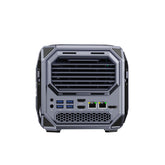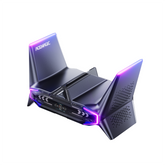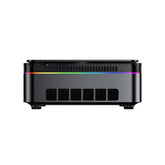Wi-Fi 5 vs Wi-Fi 6 vs Wi-Fi 7: What's the Difference and Which One Do You Need?
Wi-Fi standards have evolved rapidly in recent years, transforming how users connect their devices at home, work, and on the move. Most people are not sure if it's worth it to upgrade from Wi-Fi 5 to Wi-Fi 6, or if they should wait until Wi-Fi 7 becomes widespread.
This article summarizes the history of Wi-Fi, compares and contrasts the key differences between Wi-Fi 5, Wi-Fi 6, and Wi-Fi 7, and provides straightforward recommendations on which standard suits various requirements.

Overview of Wi-Fi Generations: From Wi-Fi 1 to Wi-Fi 7
Wi-Fi Alliance also renamed things in 2018 to make wireless standards easier to identify more intuitively for users. Instead of using technical terms such as IEEE 802.11ac or 802.11ax, the naming scheme employed simple monikers such as Wi-Fi 5 and Wi-Fi 6.
Here is a timeline of major Wi-Fi generations and their characteristics:
| Standard | Common Name | Release Year | Max Speed | Key Features |
|---|---|---|---|---|
| 802.11b | Wi-Fi 1 | 1999 | 11 Mbps | First widely used Wi-Fi standard |
| 802.11a | Wi-Fi 2 | 1999 | 54 Mbps | Used 5 GHz band |
| 802.11g | Wi-Fi 3 | 2003 | 54 Mbps | Backward compatible with 802.11b |
| 802.11n | Wi-Fi 4 | 2009 | 600 Mbps | Introduced MIMO technology |
| 802.11ac | Wi-Fi 5 | 2014 | 3.5 Gbps | Wider channels, faster 5 GHz |
| 802.11ax | Wi-Fi 6 | 2019 | 9.6 Gbps | OFDMA, improved capacity |
| 802.11be | Wi-Fi 7 | 2024–2025 | 46 Gbps | 320 MHz channels, Multi-Link Operation |
What is Wi-Fi 5 (802.11ac)?
Wi-Fi 5, released in 2014, was built on the 802.11ac standard. It operates mostly in the 5 GHz band and can deliver speeds up to 3.5 Gbps under ideal circumstances. The wider 80 MHz and 160 MHz channels facilitate faster data transfer compared to Wi-Fi 4.
The standard also brought about video streaming and online gaming performance. Wi-Fi 5, however, struggles in environments that contain many devices, causing lag in response time as multiple users connect simultaneously.
What is Wi-Fi 6 (802.11ax)?
Wi-Fi 6, which came out in 2019, introduced support for both 5 GHz and 2.4 GHz bands with maximum speeds of 9.6 Gbps. Its most notable feature is OFDMA (Orthogonal Frequency Division Multiple Access), which enables multiple devices to efficiently share a channel.
This standard improves latency, battery life, and supports more devices in dense environments. For households with smart TVs, laptops, and IoT devices, Wi-Fi 6 provides a more stable experience than Wi-Fi 5.
What is Wi-Fi 7 (802.11be)?
Wi-Fi 7 is the latest standard, and commercial hardware is expected to be released in 2024/2025. It provides peak rates of 46 Gbps, thanks to 320 MHz channels, 4K-QAM modulation, and Multi-Link Operation (MLO).
MLO enables devices to utilize multiple frequency bands simultaneously, thereby reducing latency and enhancing stability. Wi-Fi 7 is targeted at ultra-high bandwidth applications such as 8K streaming, VR/AR gaming, and enterprise networking.
Wi-Fi 5 vs Wi-Fi 6 vs Wi-Fi 7: Key Differences Explained
A leap from one Wi-Fi generation to another brings measurable differences in speed, latency, and overall capacity. The following sections list the most considerable differences.
Speed and Bandwidth
- Wi-Fi 5: Theoretical top speed of 3.5 Gbps with 160 MHz channels.
- Wi-Fi 6: Theoretical top speed of 9.6 Gbps, on both 2.4 GHz and 5 GHz bands.
- Wi-Fi 7: Up to 46 Gbps, thanks to 320 MHz channels and 4K-QAM.
While real-world speeds are lower, Wi-Fi 6 delivers nearly twice the performance compared to Wi-Fi 5, and Wi-Fi 7 boosts capacity several times more.
Latency and Responsiveness
- Wi-Fi 5: Higher latency under crowded conditions due to inefficient multi-user management.
- Wi-Fi 6: Reduced latency through OFDMA and better scheduling of data packets.
- Wi-Fi 7: Targets sub-1 ms latency, tailored for VR, AR, and cloud gaming.
Lower latency directly improves online gaming and video conferencing quality.
Device Capacity and Multi-User Support
- Wi-Fi 5: Limited simultaneous connections, crowded in busy offices or homes.
- Wi-Fi 6: Dozens of active devices are accommodated with MU-MIMO and OFDMA.
- Wi-Fi 7: Adds Multi-Link Operation, enabling devices to connect on multiple bands at once.
This makes Wi-Fi 7 especially handy in smart homes with lots of IoT devices.
Power Efficiency
Wi-Fi 6 introduced Target Wake Time (TWT), which awakens devices at pre-set times to save battery life on smartphones and IoT devices. Wi-Fi 7 continues this tradition, with even further enhanced power management for always-on devices.
Security Enhancements
- Wi-Fi 5: WPA2 encryption.
- Wi-Fi 6 and 7: WPA3, with increased protection from brute-force attacks.
Comparison Table: Wi-Fi 5 vs Wi-Fi 6 vs Wi-Fi 7
| Feature | Wi-Fi 5 (2014) | Wi-Fi 6 (2019) | Wi-Fi 7 (2024–2025) |
|---|---|---|---|
| Max Speed | 3.5 Gbps | 9.6 Gbps | 46 Gbps |
| Frequency Bands | 5 GHz | 2.4 & 5 GHz | 2.4, 5 & 6 GHz |
| Latency Target | ~30–50 ms | ~10 ms | <1 ms |
| Multi-Device | Limited | OFDMA + MU-MIMO | Multi-Link Operation |
| Power Saving | Basic | Target Wake Time | Advanced TWT |
| Security | WPA2 | WPA3 | WPA3 |
How Each Wi-Fi Standard Performs in Various Situations
The impact of each Wi-Fi standard is more noticeable when held up against common applications. Performance is not only raw speed, but stability, latency, and device capacity determine the real-world experience.
For gaming, Wi-Fi 5 can deliver stable performance under light network loads, but the moment multiple devices compete for bandwidth, latency spikes become noticeable. Wi-Fi 6 solves this by controlling traffic through OFDMA, lowering response times, and enabling a smoother online gaming experience. Wi-Fi 7 brings it to the extreme with sub-millisecond latency, supporting VR and AR environments in which delay must be virtually imperceptible.
Video streaming has also evolved between generations. Wi-Fi 5 suffices for Full HD and some 4K playback, but buffering occurs with several users streaming concurrently. Wi-Fi 6 increases capacity so multiple 4K streams can be managed concurrently. Wi-Fi 7 delivers 8K and above frame rate video without stutters, making it ideal for high-end entertainment systems.
Remote working highlights another difference. Wi-Fi 5 video calls can freeze or drop when bandwidth is shared. Wi-Fi 6 provides a stable video conferencing experience even if there are many devices connected to the same network. Wi-Fi 7's Multi-Link Operation can maintain a call by shifting traffic between bands if one channel becomes congested, bringing added reliability to hybrid workplaces.
For smart homes filled with IoT devices, Wi-Fi 5 gets saturated in a snap. Wi-Fi 6 boosts device capacity, keeping sensors, cameras, and smart appliances online without interruption. Wi-Fi 7 provides even more elbow room, supporting hundreds of devices simultaneously with minimal slowdown, which will be crucial as IoT adoption continues to expand.
Scenario Comparison Table
| Scenario | Wi-Fi 5 | Wi-Fi 6 | Wi-Fi 7 |
|---|---|---|---|
| Gaming | Moderate latency | Low latency, stable multiplayer | Sub-1 ms latency, VR/AR capable |
| Video Streaming | Full HD / some 4K | Stable 4K, multiple streams | 8K and high frame rate |
| Remote Work | Freezes are a risk | Stable video calls | Multi-Link offers reliability |
| Smart Home / IoT | Few devices | Dozens of devices supported | Hundreds of devices supported |
Upgrade Guide: Should You Upgrade to Wi-Fi 6 Now or Wait for Wi-Fi 7?
The choice between Wi-Fi 6 and Wi-Fi 7 will ultimately depend on usage patterns, device availability, and price. Wi-Fi 5 is already starting to look old, so the majority of upgrades will be to either Wi-Fi 6 or Wi-Fi 7.
For households with multiple laptops, smartphones, and smart devices, Wi-Fi 6 provides a nice balance of speed, reliability, and cost. Wi-Fi 6 routers are not hard to get and are affordable, and most new laptops and mini PCs already include Wi-Fi 6 modules. For most users, an upgrade to Wi-Fi 6 today solves the most pressing issues of slowing down during video calls or lagging during online games without requiring a high up-front investment.
Wi-Fi 7, on the other hand, is for users who require extreme performance. That it is able to bond multiple frequency bands and deliver up to 46 Gbps is beneficial to use cases like 8K streaming, professional video editing over a network, or VR and AR use cases that are immersive. Wi-Fi 7 routers remain expensive in 2025, however, and very few devices on the market support the standard. Early adopters or those with niche needs can justify the upgrade, but typical households will not yet reap the full advantage.
Wired Ethernet still has its application for competitive gamers and heavy data transfer professionals. Although Wi-Fi 7 bridges the speed and latency gap, a wired Ethernet connection still guarantees good performance where wireless interference might be a problem.
In short, Wi-Fi 6 is the practical choice for most users today, while Wi-Fi 7 is a future-proof choice for those willing to spend more money for the newest features.
Best Devices and Routers That Support Wi-Fi 6 and Wi-Fi 7
Hardware compatibility is the ultimate deciding factor when upgrading to a new Wi-Fi standard. Not even the fastest router can deliver its full potential if devices do not support the same generation.
Wi-Fi 6 has already become the norm for most new laptops, tablets, and phones released after 2020. Some small PCs and thin notebooks also have built-in Wi-Fi 6 modules, which give users more stability for streaming, conferencing, and gaming. Router options are also abundant, with models ranging from budget to mid-range to premium. This makes Wi-Fi 6 a solid and affordable upgrade for small businesses and home settings.
Wi-Fi 7 hardware began hitting the market in late 2024 and continues to spread in 2025. The initial adopters are flagship phones, gaming laptops with top-tier specifications, and high-end mini PCs. Wi-Fi 7 routers are also at the higher end of the market, with specifications such as 320 MHz channels and Multi-Link Operation that do not come cheap. The prices will decrease as availability expands, but adoption so far is limited to professionals and enthusiasts who require the best possible performance.
Conclusion: Selecting the Proper Wi-Fi Standard for Your Needs
The difference between Wi-Fi 5, Wi-Fi 6, and Wi-Fi 7 shows a consistent boost in speed, latency, and capacity. Wi-Fi 5 is already saturated in crowded networks, and Wi-Fi 6 offers a balance of performance to price that makes sense for most homes and small offices in 2025. Wi-Fi 7 offers advanced features such as Multi-Link Operation and ultra-low latency, but at a higher price point with limited device compatibility, so it is best left to professionals and enthusiasts who earn their living from the most demanding software.
For the majority of users, the upgrade to Wi-Fi 6 gives a concrete improvement for everyday tasks such as streaming, gaming, and working from home. Wi-Fi 7 is a future-proofing option to be remembered when devices and routers that support it are more widely available and cheaper.
FAQ: Frequently Asked Questions About Wi-Fi Standards
Is Wi-Fi 6 backward compatible with Wi-Fi 5 devices?
Yes. Wi-Fi 5 hardware can still connect to Wi-Fi 6 routers, but they will operate at Wi-Fi 5 speeds and features.
How often does a Wi-Fi router need to be replaced?
Most routers will last 4–6 years. Earlier upgrading may be necessary if the number of devices grows rapidly or if a new standard presents enticing benefits.
Does Wi-Fi 7 require new home cabling?
No. Wi-Fi standards are wireless. However, to achieve top speed, the router needs to be connected to an internet service that provides sufficient bandwidth, and new Ethernet cabling might be necessary for backhaul between routers.
Will Wi-Fi 7 make mesh systems unnecessary in large homes?
Not always. Although Wi-Fi 7 provides enhanced coverage and additional bandwidth, large multi-story homes may still benefit from mesh systems for the elimination of dead spots.
How important is the 6 GHz band introduced with Wi-Fi 6E and also Wi-Fi 7?
The 6 GHz band reduces interference by offering a wider, less congested spectrum. Compatible devices experience higher speeds and lower latency, especially in densely populated urban locations.
Do higher-frequency Wi-Fi signals have health implications?
Regulatory bodies like the FCC and WHO affirm that Wi-Fi signals, including 6 GHz signals, are still within safe exposure levels and are not harmful to health under normal use.
Will a switch to Wi-Fi 6 or Wi-Fi 7 enhance online gaming performance if my internet plan is slow?
Not radically. If the internet service itself isn't high-speed, the benefit will be minimal. But newer standards still reduce in-home latency when there are a lot of active devices.
What comes after Wi-Fi 7?
Wi-Fi 8 research is already underway, which will likely focus on even more efficiency, AI-powered traffic management, and coordination with satellite and 5G networks.







Leave a comment
Please note, comments need to be approved before they are published.